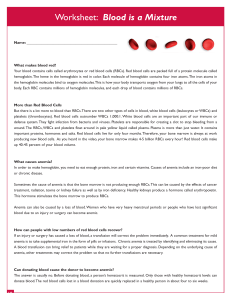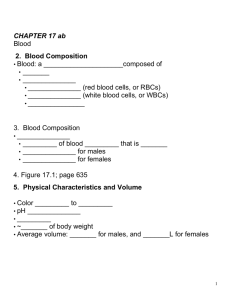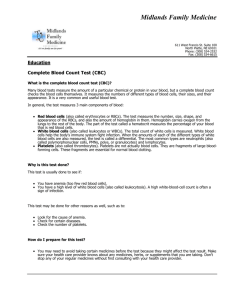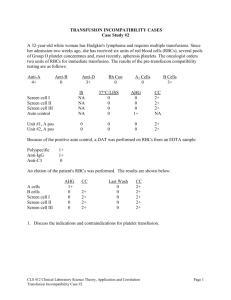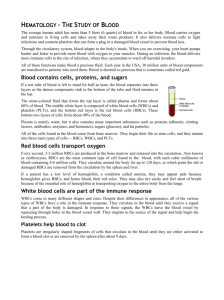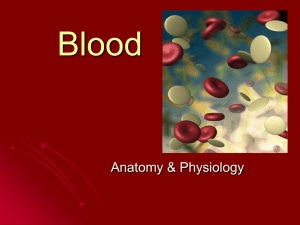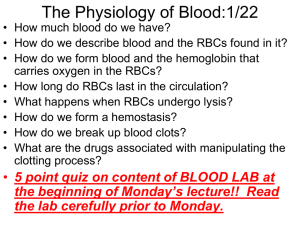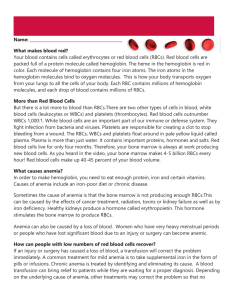CH 10 – BLOOD Review Questions
advertisement
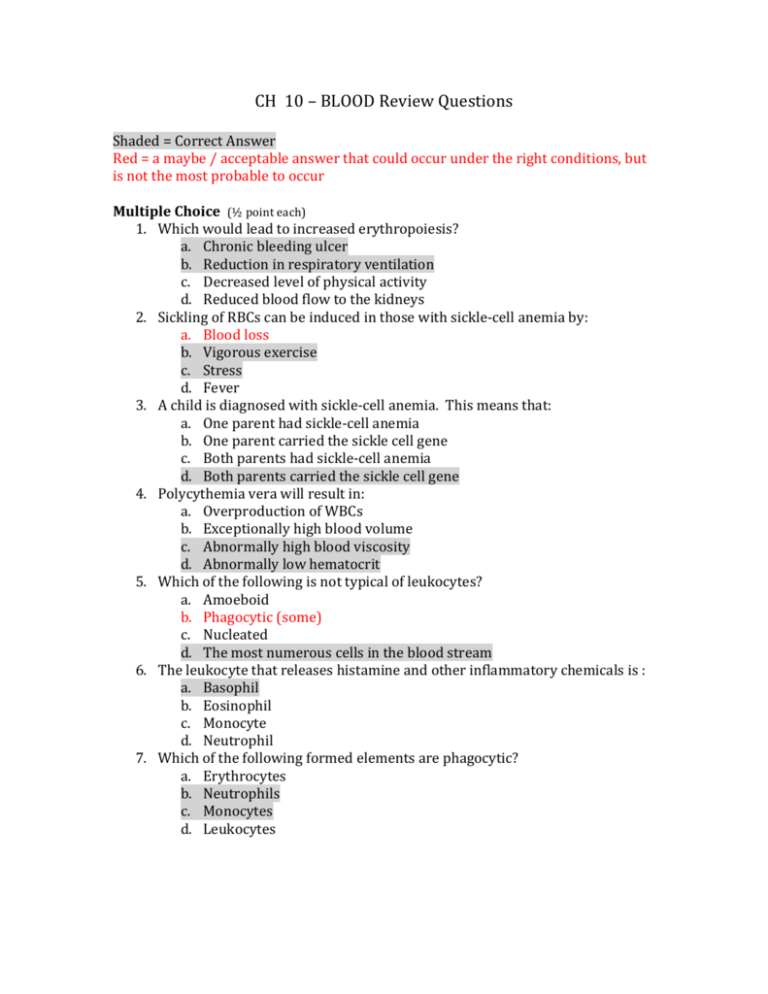
CH 10 – BLOOD Review Questions Shaded = Correct Answer Red = a maybe / acceptable answer that could occur under the right conditions, but is not the most probable to occur Multiple Choice (½ point each) 1. Which would lead to increased erythropoiesis? a. Chronic bleeding ulcer b. Reduction in respiratory ventilation c. Decreased level of physical activity d. Reduced blood flow to the kidneys 2. Sickling of RBCs can be induced in those with sickle-­‐cell anemia by: a. Blood loss b. Vigorous exercise c. Stress d. Fever 3. A child is diagnosed with sickle-­‐cell anemia. This means that: a. One parent had sickle-­‐cell anemia b. One parent carried the sickle cell gene c. Both parents had sickle-­‐cell anemia d. Both parents carried the sickle cell gene 4. Polycythemia vera will result in: a. Overproduction of WBCs b. Exceptionally high blood volume c. Abnormally high blood viscosity d. Abnormally low hematocrit 5. Which of the following is not typical of leukocytes? a. Amoeboid b. Phagocytic (some) c. Nucleated d. The most numerous cells in the blood stream 6. The leukocyte that releases histamine and other inflammatory chemicals is : a. Basophil b. Eosinophil c. Monocyte d. Neutrophil 7. Which of the following formed elements are phagocytic? a. Erythrocytes b. Neutrophils c. Monocytes d. Leukocytes 8. A condition resulting from thrombocytopenia is: a. Thrombus formation b. Embolus formation c. Petechiae d. Hemophilia 9. Which of the following can cause problems in a transfusion reaction? a. Donor antibodies attacking recipient RBCs b. Clogging of small vessels by agglutinated clumps of RBCs c. Lysis of donated RBCs d. Blockage of kidney tubules 10. If an Rh-­‐ mother becomes pregnant, when can erythroblast fetalis not possibly occur in the child? a. If the child is Rh-­‐ b. If the child is Rh+ c. If the father is Rh+ d. If the father is Rh-­‐ Short Answer Essay 1. What is the blood volume of an average-­‐sized adult? (½ point) Approximately 5 – 6 liters 2. What determines whether blood is bright red or dull red in color? (½ point) The percentage of oxygen in the blood. 3. Name as many different categories of substances carried in plasma as you can? (½ point) Water, salts (electrolytes), proteins, nutrients, respiratory gases, hormones, waste products 4. Define formed elements and list three major categories. Which category is most numerous? Which makes up the buffy coat? (1 point) RBCs, WBCs, platelets. RBCs are most numerous. WBCs and platelets make up the buffy coat. 5. What is the average life-­‐span of a RBC? How does the fact that it has no nucleus affect its life span? (1 point) 100-­‐120 days. Having no nucleus the RBC is incapable of repairing itself, thereby shortening its overall life span. 6. Define anemia and give 3 possible causes. (2 points) A decrease in the oxygen carrying capacity of the blood. Causes: 1-­‐low RBC count, 2-­‐inadequate hemoglobin content in RBCs, 3-­‐abnormal hemoglobin Hemorrhagic, hemolytic, aplastic and pernicious decrease RBC. Inadequate hemoglobin is cause by iron-­‐deficiency anemia. Sickle-­‐cell anemia causes abnormal hemoglobin in RBCs. 7. Name the granular and agranular WBCs. Give the major function of each type in the body. (2 points) Granular – Neutrophil (first responder, phagocyte), Eosinophils (kills parasitic worms, increase during allergy attacks possibly to clean-­‐up allergic response chemicals, inactivate inflammatory chemicals), Basophils (histamine discharge). A granular – Lymphocytes (produce antibodies, fight tumors and viruses); Monocytes (are active macrophages performing clean-­‐ups, increase during persistent infections. 8. If you had a severe infection, would you expect your total WBC count to be closes to 5000, 10000, or 15000 mm3? Why? What is this condition called? (1 point) 15,000 mm3, above 11,000 mm3 is a condition called leukocytosis. 9. Name the stem cell that produces all formed elements. Name the formed elements that arise from the myeloid stem cell. Name those arising from the lymphoid stem cell. (1 point) Hemocytoblast is pluripotent and forms two other stems cells the myeloid stem cell which forms all of the blood cells and platelets with the exception of the lymphocytes which are formed by the lymphoid stem cell. 10. Describe the process of hemostasis. Indicate what starts the process. (2 points) Hemostasis occurs when a blood vessel has been damaged exposing connective tissue in the vessel to the blood. 1-­‐Platelets become sticky and adhere to collagen fibers at the site forming a plug. 2-­‐Platelets release serotonin, thereby narrowing blood vessels, 3-­‐injured tissue releases thromboplastin causing coagulation to occur. 11. How can liver dysfunction cause bleeding disorders? (½point) When the liver is unable to synthesize its usual supply of clotting factors, abnormal bleeding episodes occur. 12. What is the basis of blood groups? ( ½ point) Antigens proteins on the surface of the RBC plasma membrane 13. Name the four ABO blood groups. Which is most common? Which is least? (1 point) Type A, Type B, Type AB, and Type O; most common O, least common AB 14. What is a transfusion reaction? Why does it happen? (1 point) A problem (agglutination) caused by the reaction of antibodies to foreign antigens. The reaction causes a binding that causes the RBCs to clump, which leads to clogging of the small blood vessels throughout the body. During the following hours foreign RBCs are lysed. Free hemoglobins are released into the blood stream and may cause blockages in the renal tubules and potentially cause kidney failures. 15. Explain why an Rh-­‐ person does not have a transfusion reaction the on the first exposure to /Rh+ blood. Why is there a transfusion reaction the second time he or she receives Rh+ blood. (1 point) 1st exposure – no memory effect has yet built up in the immune system response. The 2nd exposure has the memory. 16. If you had a high hematocrit, would you expect your hemoglobin determination to be high or low? Why? (1 point) A hematocrit is a red blood cell count giving the percentage of RBCs to total blood volume. Higher. 17. What blood-­‐related problems are most common to the aged? (½ point) The elderly are susceptible to forms of anemia and leukemia, especially to pernicious anemia as the stomach mucosa atrophies with age.


